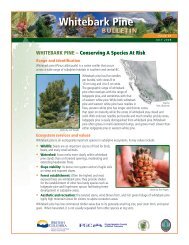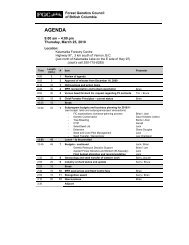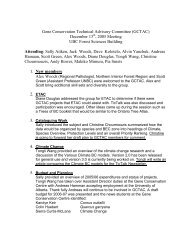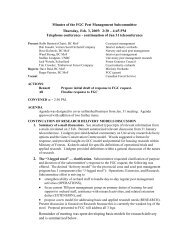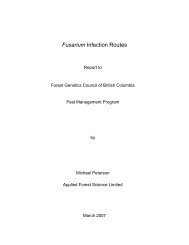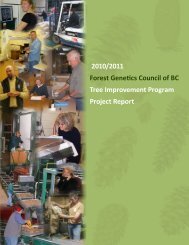Tree Improvement Program Project Report 2006 / 2007
Tree Improvement Program Project Report 2006 / 2007
Tree Improvement Program Project Report 2006 / 2007
Create successful ePaper yourself
Turn your PDF publications into a flip-book with our unique Google optimized e-Paper software.
F gure 39. Younger yellow cedar donor stock weeks after<br />
m d-season prun ng.<br />
.2. Effect of Selfing and Flower ng<br />
Phenology on Seed Product on<br />
n Yellow-cedar Seed Orchards.<br />
(SPU 1112)<br />
Oldr ch Hak<br />
Results from a current study indicate that low-elevation<br />
yellow-cedar seed orchards are capable of producing viable<br />
seed (see <strong>Project</strong> <strong>Report</strong> 2004/2005). The study further<br />
shows that both low-elevation males and low-elevation<br />
females can produce viable seed. This is contrary to earlier<br />
reports that low-elevation seed orchards established on<br />
Vancouver Island are not able to do so. One possible<br />
answer to this discrepancy lies in the pollination method<br />
employed in each case. Open pollination was practiced in<br />
the early seed orchards at low elevation. Similarly, when<br />
open-pollinated cones were collected in the current study,<br />
they also produced empty seed. However, when control<br />
6<br />
T R E E I M P R O V E M E N T P R O G R A M<br />
P R O J E C T R E P O R T 2 0 0 6 / 2 0 0 7<br />
F gure 0. Younger yellow cedar donor stock.<br />
pollination was used, the cones produced viable seed.<br />
There was an abundance of pollen on the tested trees and<br />
on surrounding trees for open pollination. This suggests<br />
that there may be several unknown and untested factors<br />
responsible for this failure.<br />
The objective of this project is to test three possible<br />
causes for empty seed production in open-pollinated seed<br />
orchards: selfing, flowering phenology (timing of natural<br />
pollen shed vs. timing of the receptivity of female flowers)<br />
and insect damage.<br />
The study is being carried out at two locations at two<br />
different time periods. The first trial was initiated at the<br />
Mount Newton seed orchard in spring 2005, and the<br />
second trial was initiated at the Western Forest Products<br />
seed orchard in spring <strong>2006</strong>. Pollinations were completed<br />
at Mt. Newton in winter <strong>2006</strong>, and at Western Forest<br />
Products the pollinations will be done in winter <strong>2007</strong>.<br />
Cones will be collected and seed will be extracted one<br />
year after pollination; the percentage of full seed for each<br />
treatment will be determined.



